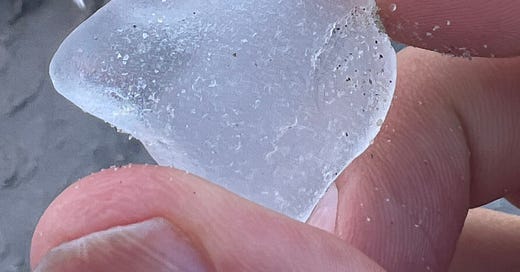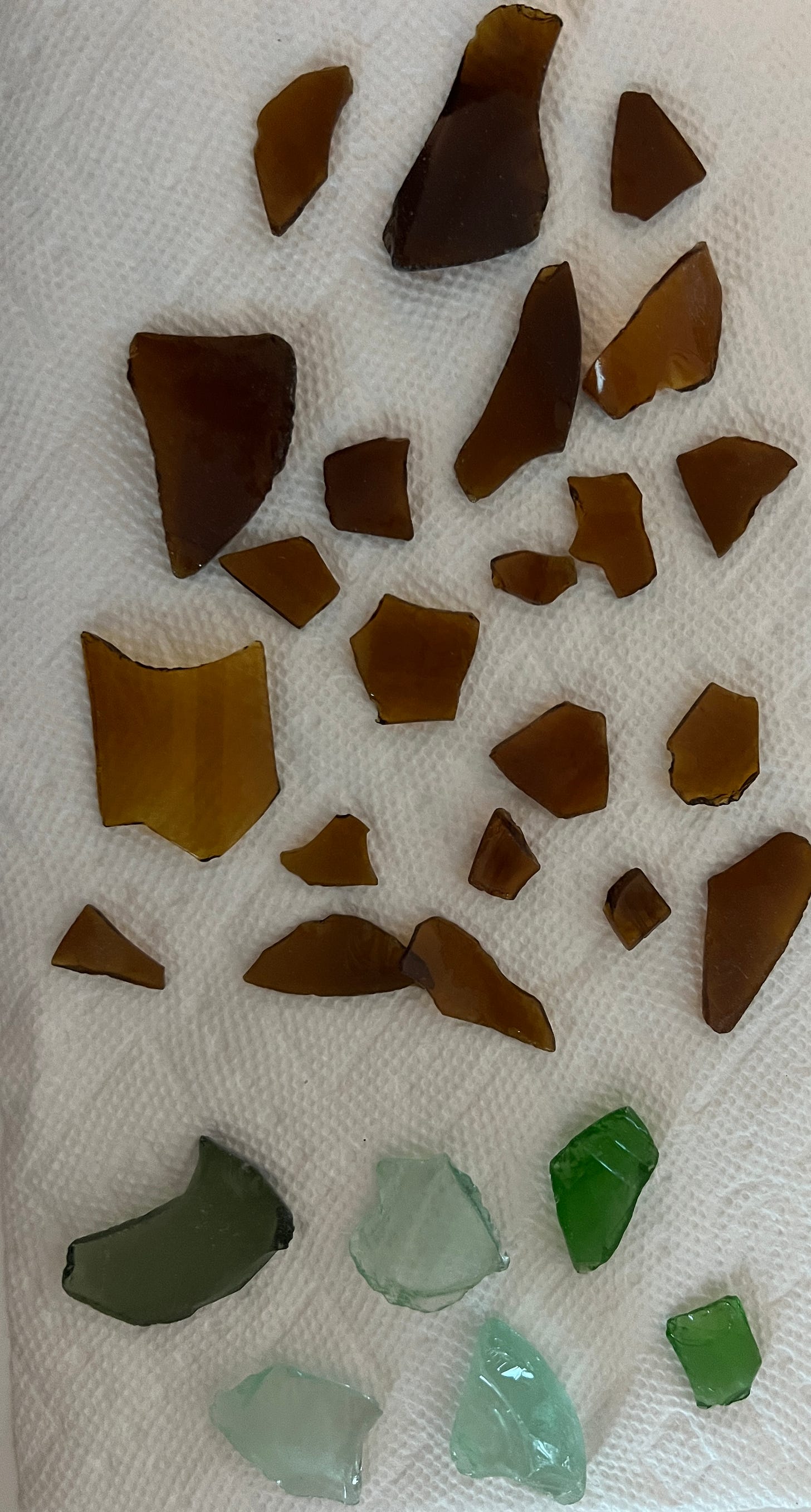After calming the seas and averting a storm that threatened to wreck the ship of a captain she had followed on many voyages, Neptune banished the mermaid to the depths of the ocean, where her tears wash ashore as glass.
Nearly everyone we knew with a beach house in the 1970s had a jar of sea glass in the kitchen, the TV room or in multiple bathrooms. It was abundant in clear, green, brown, and rarely some blue from an apothecary or Bromo-Seltzer bottle. Pre-dating recycling programs and a deeper understanding of ocean ecologies, bottles were dumped in the ocean with other trash. Over the next years, those bottles broke, tumbled, and were polished to remove their transparency, roughness and obvious history as they completed a three mile tumble into the surf. The stochastic motion of tide and time wore them smooth, the ocean taking in refuse and returning something of beauty.
My friend J once broke a yellow drinking glass and wanted to dump it on the rocky jetty on the beach by her house, thinking it would be the yellow unicorn of sea glass in a few days. Absent the weather, tide and oceanographic analysis to know that it would drift southward, and the history that well-worn sea glass may take a decade or more to become frosted, she merely wanted to turn an accident into a story.
Barefoot girl, sittin’ on the hood of a Dodge, drinking warm beer in the soft summer rain — Bruce Springsteen, “Jungleland”
Skip five decades. We have recycling, we don’t use the ocean as an infinite garbage disposal, and fully tumbled sea glass has to evade beachcombers and beach garbage sweeps. The mermaid’s tears are truly unicorns now; the beach remains littered with broken heroes from a night out on the boardwalk, the pier, or the jetties.
My daily walks at low tide this summer turned into a scientific and then philosophical study of sea glass. I was averaging about ten pieces of glass per mile walked, mostly broken beer bottles, with sharp edges and encoding more recent stories. What started as a simple beach diversion turned into a bit of a social conscience – I took a quart of broken glass off of the beach over a literal month of walks. With that hour of each day focused on nothing more than the sand between my toes, I developed a philosophical view of my search.
The hours on either side of low tide are the best, and walking with the sun to my back made it easiest to detect the glimmer of glass in the sand. I began to recognize the canonical shapes: the thin walled, lightbulb swell of a Michelob brown bottle, the narrow neck of a clear Corona bottle, the squared off bottom from the last of the Fireball and the slight green variations in Heineken and Rolling Rock bottles.
They all told stories. Springsteen’s girl on the car’s hood finishes the bottle and tosses it away, for its shards to drift south as she returned north to New York City. Some of my found fragments have letters in the raised print of a different age and craft. One piece of opaque white and green glass appears to have come from an accountant’s lamp shade; we may be of the same vintage. The bottles tell the stories of a hundred summers, a hundred stories where hearing the glass shatter in the dark is an echo of both possibility and the unknown.
I finished Becky Chambers’ “A Prayer For The Crown Shy” mid-way through the summer, the second book in her “Monk and Robot” series that explores what it means to distinguish ourselves as human (or robot). There is a lovely interchange where Mosscap, the referenced robot in the series, decides it will only be repaired with things native to original robot manufacture, thus not altering its very nature.
Glass and sand are material cousins. As Sun’s John Gage used to say, our technical lives are made possible by sand that re-appears as glass fiber optic cable and silicon semiconductor chips. Yet my daily serpentine stroll - minus the benefits of fiber optics and semiconductors - prompted me to think of glass as the non-native beach material. Broken shells, pebbles, the random crab claw too small for a seagull’s beak will all further break down and sediment in the ocean; glass doesn’t return to its silica origins quite so easily or quickly. We conclude a Jewish wedding ceremony by breaking a glass — as explained by a favorite rabbi, the glass can’t ever return to its previous state, as neither will the married couple. The mathematics of predicting how glass will shatter are rank in complexity with weather prediction, the thermodynamics of soft serve ice cream, understanding Parkway traffic and other invariants of our New Jersey summers.
Picking up glass was my way to restore the long term nature of the beach, removing the telltales of these recent stories, forcing them to be told in other songs of the summer.





Beautiful journey on the beach and imagination Hal. Thanks for sharing!